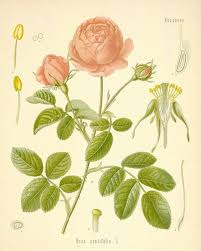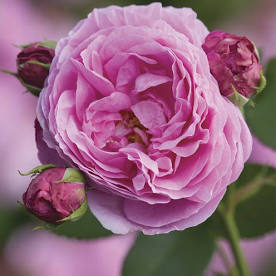This revered 'queen of flowers' is believed to be one of the earliest flowering plants ever cultivated and is steeped in myth and magic. The rose has inspired poets and artists for centuries as the symbol of love and beauty. Associated with most religions, it appears in the sacred texts of ancient India and China, the writings of Christian mystics, and the religious texts of the Greeks.

The Romans and the Gauls would often go into battle with only a crown of roses for a helmet, to show their fearlessness.
Although the rose has always been estimated as the most precious perfume material, it doesn't seem likely that early civilisations used the distillation process. Instead, the perfume was preserved by steeping the petals in oil or animal fat. By the 10th century AD, however, the Persian physician Avicenna had perfected steam distillation and created the first rosewater.
By the turn of the 16th Century, the essential oil or 'attar of roses' was discovered - by chance. At the wedding feast of the Mogul princess Nour-Djihan, a canal circling the palace gardens was filled with rosewater and covered with rose petals. The bridal pair, while rowing on the fragrant water, noticed an oily substance floating on the surface. It was skimmed off and found to be an exquisite perfume. The heat of the sun had begun a process of natural distillation. After that, the production of rose otto (the traditional name for the steam-distilled essential oil) began. By the 17th century the distilleries of Shiraz were highly productive. From Persia, the cultivation and distillation of roses spread to India, then Turkey and the rest of Europe.
The Rose's Origins

There are numerous species and hybrids of wild and cultivated roses. Most have culinary and medicinal properties. But the two heavily scented species valued for their essential oil an rosewater are the damask rose (Rosa damascena) and the cabbage rose (R. centifolia)
The damask rose grows to about 1.5m tall, producing an abundance of 36-petalled pale pink flowers and bright red rosehips. Although native to Syria, it is cultivated mainly in Bulgaria and Turkey for the production of rose otto. The slightly taller cabbage rose is so called because its many-petalled, pink flowers fold over like cabbage leaves. The birthplace of the cabbage rose is said to be ancient Persia, although it is now cultivated mainly in Morocco, Tunisia, Italy, France and China for its essential oil.
Extraction of Rose Oil
There are two types of rose oil commonly available: rose otto, captured by steam distillation of the fresh petals; and rose absolute, obtained by solvent extraction of the fresh petals. Solvent extraction uses volatile chemicals such as petroleum ether and hexane. Because of this, the distilled rose otto is generally preferred for aromatherapy. Rosewater is a by-product of distillation. Rose otto is virtually colourless and semi-solid at cool temperatures.
The steam-distilled rose otto is one of the most expensive essential oils, because the flowers excrete such a minute amount. It requires 60,000 roses (57kg) to make 28g of rose otto. The solvent-extracted rose absolute is less expensive because a great deal more of it is produced, mainly for the perfume industry. The fragrance of rose otto is sweet and mellow with a hint of cloves and vanilla. Rose absolute is a deep yellow, slightly viscous liquid with a sweet, mellow scent. The odour effect of both is warming and relaxing, and reputedly aphrodisiac.
Healing Power
In the Middle Ages apothecaries prescribed rose for tuberculosis. Teas made from the petals and/or leaves were used for poor circulation and digestive problems, irregular and painful periods, liver congestion, fevers, eye infections, skin complaints, headaches and nervous tension.

Rosehips, particularly those of the wild rose (R. canina), have a high amount of vitamin C, containing four times as much as blackcurrants and ten times the amount in oranges and lemons. Rosehips were recognised as a rich source of vitamin C during the Second World War; this prompted the British Ministry of Health to distribute rosehip syrup. Now, people are wary of taking it because of its high sugar content, and rosehip tea is a healthier alternative.
In aromatherapy, rose otto is seen as the supreme tonic for the female reproductive system. It can also benefit anyone with a nervous disposition. To calm and soothe, massage the diluted oil into the solar plexus or add a few drops of pure essential oil to your bath. Rose otto is also a marvellous skin care oil. And distilled rosewater is one of the finest skin tonics; it can even help soothe stress-related eczema. Cotton wool pads soaked in rosewater, applied as a compress, soothe sore, itchy and tired eyes.
Rosehip seed oil is an increasingly popular aromatherapy product. This 'fixed' vegetable oil is extracted from the hairy achenes (known as seeds) enclosed in the rosehip. This light-textured, vitamin-rich oil is believed to promote the regeneration of healthy skin cells. With or without the addition of essential oils, it makes a perfect skin care oil for the face and neck.